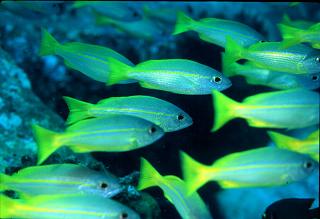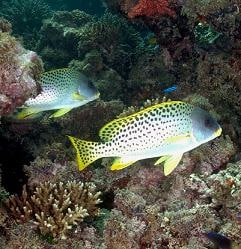Focus for today:
The Reef Fish Surveys Are Underway.
Target key stage:
Key Stage 4: Double Award Applied Science; Unit 3, Monitoring living organisms.
Key information:
At each research location on the reefs in the Farasan Islands a team of six divers leaves the Golden Shadow in a small boat to conduct habitat and reef fish surveys at up to three sites per day. The four habitat survey divers enter the water first to deploy two 50m long transect tapes on the bottom along a specific depth contour. About 30 minutes later, after the photo transects of the habitat have been completed, the two divers for the reef fish surveys descend to the bottom and conduct a census of the fish along one of the 50m transect lines. Each diver counts the number and size of each species of fish they see in a 2m wide strip along their side of the transect line, that extends from the bottom to the surface.
The reef fish surveys team
Visual reef fish surveys require the divers to have good knowledge of what each fish species looks like, and to be able to quickly record key characteristics (such as, color patterns, shape of the body and fins, swimming behavior) of fish that they do not recognize to aid in later identification using reference materials. This is quite difficult because most species of reef fish change their color and body shape many times as they grow from juvenile to adult. Also, the divers need to keep moving along the transect line to simulate recording an “instantaneous picture” of the fish, and there is not time to write the scientific or common name for each species they see. To make this visual survey method work, each fish survey diver quickly develops their personal system of “shorthand notations or symbols” for each species of fish to quickly record them on an underwater survey data sheet. For example, the long-barbel goatfish, Parupeneus macronema, that has a unique color pattern of a long dark line along the side and a dark spot in a white area near the tail, is recorded on the data sheet as “—— *”. This shorthand notation is changed to “—– * Y” for the similarly colored Forsskal’s goatfish, Parupeneus forsskali, that has the dark spot in a yellow colored area.
Reef fishes – snappers
Fish censuses have been conducted along 12 transects so far in the Farasan Islands. The number of species off fish on each transect has ranged from 20 to 50, and averaged 31 species. By far the most difficult fish to survey are the juveniles because they have many unusual color patterns and they hide from the divers, who likely look to them like very large predators. Each diver always records a number of different species on their side of the transect line, even though the 2m wide strips being surveyed are side-by-side. Usually about 80-85% of the species of fish are the same on both sides of the transect line. The reef fish surveys have recorded information for 120 species, and this number may be as high as 220-250 by the end of the expedition.
Sweetlips – common on reefs
Question for students/food for thought:
How long do you think it would take to develop and memorize a system of “shorthand notations and symbols” to visually identify 50 fish? Try developing a shorthand system for identifying song birds or insects, and you and a survey partner quickly walk a visual strip transect in your school grounds or at the park.
Additional information:
Today we retrieved the underwater CASI targets. The water visibility was not particularly good during this dive, and so it took time to locate them. However, during this dive we were lucky to observe a nurse shark, a stingray and a turtle – not bad for a days work!


